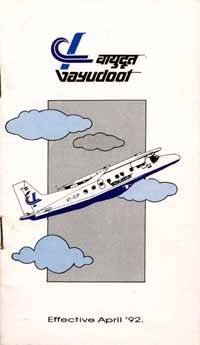PF VDT | VDT VAYU Ceased operations April 1, 1997 Founded 20 January 1981 | |
 | ||
Fleet size 21 passenger aircraft16 agricultural aircraft Parent company Indian AirlinesAir India | ||
Vayudoot top 5 facts
Vayudoot ("messenger who rides on the wind") was a regional airline in India established on 20 January 1981 as a joint-venture between the two state-owned carriers, Indian Airlines and Air India. The airline was headquartered at New Delhi's Safdarjung Airport.
Contents
The airline was originally conceived to serve the Northeastern region of India where the surface transport facilities were inadequate and surface routes were circuitous. The regional hub for the Northeast Region was Calcutta (Kolkata) and the airline built up operations to close to 30 destinations in this challenging area. Many of the airfields saw the resumption civil flights and fixed-wing aircraft after a gap of many decades.
The airline consistently lost money since its formation. The Government, struggling to find a solution to Vayudoot's continuing financial problems, considered closure and privatisation as options as the carrier's route and fleet structure made the operation unprofitable.
History
In the late 1970s, the Government of India and its two airlines became aware of the increasing number of potential air travellers in many small towns around the nation. Vayudoot was started to expand India's domestic air transport network on a very large scale, with a completely new network designed to feed Indian Airlines' network at state capitals and other big cities. hence all Vayudoot destinations (apart from its hubs) were completely new, not covered by existing Indian Airlines services.
Vayudoot began operations on January 26, 1981, India's Republic Day, in the remote north-east of the country, linking towns in states such as Assam, Manipur and Tripura. A journey such as one from Lilabari (North Lakhimpur) in Assam state to Ziro in the neighbouring state of Arunachal Pradesh could take a few days during inclement weather, braving hazards such as avalanches in the hills and flooding in lower lying areas. The flight, on the other hand was as short as 12 minutes, though weather could cause disruptions because this was flying where visual contact had to be maintained with the ground/terrain in the absence of reliable aids for navigation. The weather caused poor visibility on account of heavy rains and low clouds and/or fog and could at times result in waterlogged runways. Many runways were unpaved or dirt strips and facilities at these airports were very limited.
Its first aircraft were two F.27s leased from Indian Airlines and linked 20 destinations. To keep costs low, Vayudoot did not serve in-flight meals and contracted out its ground handling services to local agents at all smaller destinations. Vayudoot supplied basic ground-handling equipment to the agents and trained their staff. Vayudoot started with retired flight crew of Indian Airlines to fly the HS-748 and F-27 aircraft. As Dornier Do 228 were bought / leased, new pilots were recruited. The same held for the core engineering team as well, which comprised almost all of ex-Indian Airlines engineers.
Vayudoot became a public company in February 1983, owned jointly by Indian Airlines and Air India. At this time, its load factors were less than 50 per cent. Vayudoot's first Dornier 228 began service in 1985 on the Delhi-Raebareli-Lucknow route. A total of ten Do.228s were ordered by Vayudoot.
Subsequently, the services of Vayudoot were extended to other regions, charting 100 stations in the country earning the sobriquet "worlds fastest growing airline". Vayudoot quickly established hubs at Bombay (now Mumbai), Delhi, Madras (now Chennai), and Hyderabad. Sub-bases were, at some points of time, established at Bhopal in Madhya Pradesh and Guwahati in Assam. The lack of adequate traffic to sustain operations on all these routes adversely affected the company's financial performance. After a review, the number of stations on the operational network was brought down to 48 on 31 March 1991. Vayudoot was then focused on consolidating its operations and rationalizing its fare structure rather than embark on large-scale expansion of its network. Its operations were again primarily restricted to the Northeastern region and other inaccessible areas.
Vayudoot also operated an Agro Aviation Division which was involved in aerial spraying operations, seeding and afforestation operations.
Vayudoot's financial performance continued to deteriorate which finally led to the dissolution of the company and merger of its assets into Indian Airlines in 1993. On 1 April 1997 its flight operations were transferred to Indian Airlines and its employees were absorbed into Indian Airlines and Air India.
Night Air Mail Service
In 1985, Vayudoot started operating the Inland Night Air Mail Service (NAMS), a domestic overnight airmail service for the Indian Postal Service. The facility of this Vayudoot airmail service was also extended to a private courier. Every night, flights from the major metropolitan cities of India converged upon Nagpur Airport in the centre of the country. Usually the routing was :
Despite a successful run of over a year, the service was discontinued because of demanding nature of the operation. The unpressurised Dornier Do 228 was limited to an altitude of 10,000 ft. The aircraft was dependent on ground-based en route navigational facilities and these were far and few between on many of the legs. Flying exclusively at night and negotiating violent storms called Kal baisakhi, followed by the Monsoon and in the absence of Radio navigation aids it became advisable discontinue the operation.
During the early 90s, Vayudoot used leased aircraft from Royal Nepal Airlines and Ariana Afghan Airlines to run night metro flights between New Delhi, Bombay and Bangalore. Aircraft such as the Boeing 757 and Boeing 727 were used.
Destinations
Vayudoot flew to over 100 destinations during its existence.
Accident/Incidents
The airline had four safety incidents during its operational history, including two crashes which resulted in a total of 45 fatalities.
Fleet
As of March 1991, Vayudoot's passenger services had a total fleet of 23 aircraft.
Its Agro Aviation Division had a fleet of one helicopter and sixteen aircraft.
